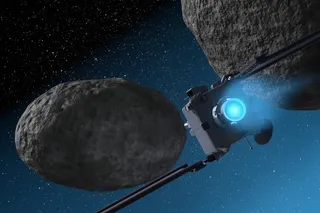The Blue Brain Project
Scientists rely on computer models to understand the toughest concepts in science: the origin of the universe, the behavior of atoms, and the future climate of the planet. Now a computer model is being designed to take on the human brain. Neuroscientist Henry Markram of the Brain Mind Institute at the École Polytechnique Fédérale in Lausanne, Switzerland, has spent the last 15 years painstakingly mapping cells from the living brains of rats so that he can create a neuron-by-neuron simulation of the brain. With assistance from IBM (whose nickname, Big Blue, helped name the project), Markram hopes to have a virtual human brain, with all its 100 billion neurons, functioning by 2015.
Scientists still don’t understand many of the most essential functions of the brain, like memory or the fundamentals of brain disease and treatment. Markram’s model will electronically mirror the real brain’s biological behaviors, imitating mathematically the interactions among individual neurons and the effects of neurotransmitters on those cells. The model will also be adjustable so that it can explore unusual physiology (a higher-functioning left hemisphere, say, or a weakened hippocampus) and environmental changes (like the effects of taking a pharmaceutical). The data can then be interpreted via computer images. “We are building a generic template,” Markram says, “which will allow us to reconstruct a brain according to any specifications.”
To grind through the immense amount of data, IBM has custom-tailored one of its most powerful supercomputers, capable of processing more than 22 trillion operations per second. With this computer, Markram has created a preliminary model of a neocortical column—a set of about 10,000 cells that work together—equivalent to one in the brain of a 2-week-old rat. “We have achieved the ability to build a brain microcircuit, an elementary unit, and now it’s just a matter of scaling up,” he says.
Many of Markram’s colleagues think that he is too ambitious, that a model of billions of neurons, no matter how intricate, cannot tell much about the functions of a real brain. “People think that it is impossible,” he admits. “They believe that we don’t understand enough about the brain to build it.” He counters that mysteries of brain circuitry will be resolved as the project moves forward over the years.
If the Blue Brain team succeeds, scientists will for the first time have a meaningful physical model of the human brain. So could a fully functioning virtual brain have the ability to create thoughts of its own? Markram isn’t counting on it, but he will be watching closely if Blue Brain begins to make its own decisions, providing unique outputs to identical inputs in a way that is beyond chance or chaos theory and achieving something that has never been observed in a computer: consciousness. “Once we build the whole brain,” he says, “if consciousness emerges, we will be able to study it systematically and understand exactly how it emerges.” —Susan Kruglinski
The Earthtime Project
About 250 million years ago, some disaster wiped out 90 percent of life on Earth, a cataclysm known as the Permian-Triassic extinction. Around the same time, volcanoes a million times bigger than Mount Saint Helens erupted, spewing enormous clouds of dust and gas into the sky and covering the ground with 2 million square miles of molten lava. Did the volcanic eruptions cause the extinctions? The answer depends on which event occurred first and how long each took—and right now, scientists just don’t know.
Such is the case with most of the big questions about the history of the Earth, says Paul Renne, director of the Berkeley Geochronology Center: “Often, our arguments about causality depend on timing.” That’s why he and hundreds of other scientists around the world have joined Earthtime, a 10-year endeavor to nail down the sequence of past events on Earth by refining scientists’ techniques for measuring deep time. The project was started by Sam Bowring, an expert in geologic time at MIT, and Douglas Erwin, a paleontologist at the National Museum of Natural History, who conceived of Earthtime during a transcontinental flight together a decade ago. “If we really want to understand the history of the Earth, we have to push our dating tools to their limits,” Bowring says.
Over the past 10 years, such tools have become astonishingly accurate and precise. Take radioisotope dating, which scientists do by measuring the relative abundance of certain forms of elements (like potassium-40) called isotopes and then using the known decay rates of those elements to calculate the age of the minerals in which they are found. In the 1970s, scientists using radioisotope dating could pinpoint the age of a 100 million-year-old rock to within a few million years. Today Bowring and others have whittled the uncertainty down to less than 100,000 years.
But a few glitches are preventing scientists from making the most of these improvements. First, separate labs using the same dating techniques employ slightly different materials and methods, leading to different results. This didn’t matter when measurements of deep time were rough. Now that the science is more exact, though, small inconsistencies due to experimental error can spark big disagreements. “It’s when we sharpen our tools that these discrepancies turn up more glaringly,” Renne says.
The problem gets bigger than that, though. For dating ancient life (what lived millions, not just thousands, of years ago), the radioisotope world includes two camps: those who tell time by uranium and those who use potassium. There are also entirely different methods for calculating deep time. Some scientists read the fossil record. Others study regular astronomical cycles that leave traces in the physical and chemical properties of rocks. These cycles occur because Earth’s orbit and orientation to the sun shift, slowly but steadily, causing recurring changes in sunlight and climate patterns. Yet rarely does anyone check whether dates derived from these different techniques agree. It’s as if every scientist is reading from his or her own watch, but nobody’s watch is synchronized with anyone else’s.
Earthtime’s goal is to synchronize the numerous watches worn by scientists who study deep time, then use them to create one superaccurate chronology of Earth’s past. To do this, Bowring and his colleagues have distributed a set of reference materials called standards (rock samples with known ages) and tracers (small quantities of isotopes with a known composition) to help make different labs’ results consistent. Until now, labs have used varying standards and tracers, which has led to differing results. Bowring hopes to eliminate such problems by giving everyone the same starting point.
Bowring and his fellow keepers of deep time are also searching for rock beds where scientists can test how well dates derived by different methods agree. And they are looking for new samples of ancient material to fill in details about ancient events. For instance, next year the ship JOIDES Resolution is scheduled to drill into the floor of the Pacific Ocean to extract rock cores that will span the period from about 53 million to 18 million years ago, a time of vast climate change.
If it works, Earthtime should enable scientists to study new, previously unappreciated aspects of Earth’s past. Erwin compares the endeavor to the Human Genome Project, in which scientists mapped the sequence of our genes. “The fundamental goal of the Human Genome Project wasn’t the genome itself—it was figuring out what our genes do,” Erwin says. “Our goal is to produce a better timescale so we can go out and start asking a whole new set of questions.” —Erika Check Hayden
Planted Forests Project
On the Southeast Asian island of Borneo, loggers, conservation biologists, and indigenous groups are coming together to test a new model of land use that gives everyone a piece of the pie. If their plan succeeds, it could be replicated in tropical regions around the world, protecting biological diversity while allowing the local people to enjoy the economic benefits of productive land.

The Sarawak state government in Malaysia commissioned the Planted Forests Project in an attempt to have it all: economic development, wildlife protection, and land use by local people. Nearly 1,900 square miles have been allocated for the planted forests zone. Slightly less than half the land is earmarked for the logging of acacia trees—a fast-growing species that can be harvested for paper. More than 30 percent of the land will be set aside for conservation. Indigenous people will continue to live on the remainder.
Biologist Robert Stuebing, who set up the conservation department of Grand Perfect (the government’s timber contractor), says the project was inspired by a map of the region showing where the government planned to plant acacia. Some areas would be used for the logging plantations, while others would be left alone. Stuebing realized that the network of undisturbed patches could serve as a haven for native plant and animal life. “Even if less than the whole habitat is protected,” he explains, “as long as you have enough bits and pieces and these are connected, you might be able to maintain a good sample of biodiversity.” Working with the loggers and the state forest department, he created corridors of land linking the forest conservation areas so wildlife can travel among them. Other conservation and development projects are also using protected passageways as a way to save native species. The question for all these initiatives is whether the corridors will actually allow enough movement to preserve populations of wildlife.
Stuebing’s first priority was to begin an inventory of what was living in the forest zone. Researchers have counted bearded pigs, deer, small mammals, birds, frogs, fish, and dragonflies and are now in the process of surveying fungi. The department keeps a log of every species identified, where it was sighted, whether it is endemic (exclusive to the region), and what its international and local protection status is. Despite previous logging and farming in the planted forests zone, more than 400 vertebrate species, including bears, civets, macaques, leopard cats, mongooses, pangolins, and porcupines, have been spotted there. Researchers have even discovered 18 snails that have never been seen anywhere else on Earth. “The beauty of the project was to see that there was such resilience and survivability of the fauna,” Stuebing says.
How the giant new acacia plantations will affect this diversity remains uncertain. Some carnivores, frogs, and squirrels seem to have taken to the planted areas more quickly than birds, bats, and snakes. With a considerable financial stake in the logging project, the government is unlikely to give up on the acacia stands, even if monitoring shows that they are harming biodiversity. But in a part of the world where human livelihood depends on the forest, this experiment at integrating wildlife protection into the mix is a big step in the right direction, Stuebing says: “It looks sustainable, and biologically, I really think this model will work well.”
If he’s right, sustainable developers around the world may copy his strategy as they struggle to balance the needs of humans and wildlife. —Jennifer Barone
Dark-Matter Experiment
For 75 years, scientists have vainly searched for particles of dark matter, the invisible substance believed to pervade deep space and to glue galaxies together. Next year, in a vat of chilled liquid buried deep in a cave in central Italy, the universe may finally be ready to give up this great secret. An international team of physicists is preparing XENON100, a simple experiment with a huge ambition: to record the moment when a bit of dark matter—known as a weakly interacting massive particle, or WIMP—smacks into the nucleus of an atom of liquid xenon, triggering a flash of light and an electric charge. “We definitely have a chance to see these events,” says Columbia University physicist and XENON team leader Elena Aprile.
According to the latest theories and observations, the universe has about six times as much dark matter as the atomic matter that makes up our ordinary world. But even though uncounted billions of dark-matter particles pass through Earth (and right through you, in fact) every second, they cannot be seen; they have no electric charge and interact so infrequently with atomic matter that the only way we can hope to find them is by laying a clever trap.
Currently there are about 10 teams of scientists devising experiments to discern the elusive moment when a stray WIMP nudges an atom of ordinary matter, but the latest version of XENON will be by far the most sensitive. All the experiments are lodged far below Earth’s surface to shield the detectors from background radiation. The Italian Gran Sasso National Laboratory is located nearly 4,600 feet beneath the top of a mountain, in caverns off a highway tunnel.
XENON100 is a scaled-up version of XENON10, one of Aprile’s earlier dark-matter experiments. It uses liquid xenon, an inert gas at room temperature, to catch WIMPs. The detector is a stainless-steel cylinder surrounded by a protective “castle” made of two kinds of lead and a layer of polyethylene to screen out residual background interference. Inside, 330 pounds of xenon will be chilled to –140 degrees Fahrenheit. Xenon’s attractive property is that it gives off a brief flash of light if a WIMP bumps into the nucleus of one of its atoms. A set of sensors on the cylinder bottom records this signal, while sensors on top detect the minuscule release of electrons liberated by the WIMP. By reading the two signals and measuring the time interval between them, researchers can fix the point of impact within the cylinder in three dimensions.
Dark matter is not necessarily composed of WIMPs—theorists have identified a host of other possible dark-matter particles—but they are the leading candidates because their presence would close a loophole in the reigning theory of particle physics, called the standard model. To address this discrepancy, scientists have proposed that all particles have large-mass counterparts, or superpartners. The neutralino, even with a mass at least 50 times that of a proton, would be the lightest of these. It is a prime WIMP candidate.
If XENON100 uncovers the long-rumored neutralino, it will mark another huge step in science’s grand humbling of humanity. “Copernicus discovered we’re not the center of the universe,” says Yale physicist Daniel McKinsey, a member of the XENON10 team. “If we find dark matter, we will discover that we are not even made of the stuff that composes most of the universe.” —Guy Gugliotta
The Census of Marine Life
What lives in the ocean? In 2000, this deceptively simple question spawned a $650 million study to catalog all sea life: plants, animals, bacteria, and fungi. “We simply had no concept of the diversity of life in the ocean,” says Rutgers University biologist Fred Grassle, who chairs the Census of Marine Life’s scientific steering committee. “Whether it was coral reefs, the deep seafloor, or even what lives in people’s backyards along the shore—so little was known.” By helping researchers identify threatened species and habitats, the census will allow better protection of the ocean’s resources. Newly discovered creatures could also provide a gold mine of natural chemical compounds useful as pharmaceuticals or for industrial applications.

Found by the Census of Marine Life: The amphipod Eusirus holmii, a small shrimplike crustacean. Image courtesy of Russ Hopcroft
It takes time to cover something as large as the world’s oceans, so the 2,000-plus census takers from more than 80 countries have broken up their assignment into 17 more manageable subgroups—like coral reefs, continental shelves, and mid-ocean ridges—that should provide a good overview of what’s out there. Teams of marine scientists are towing nets to scoop up plankton, tagging large predators to track their migrations, sequencing the DNA in seawater to hunt for microbes, and trawling the seafloor for bottom dwellers.
The scale and scope of the Census of Marine Life go beyond any previous biological survey, but 7 years into the 10-year initiative, Grassle reports that work is progressing on schedule. About 5,300 previously unknown organisms have already been identified, and every new sighting is logged into the census’s freely accessible Ocean Biogeographic Information System (www.iobis.org), which boasts more than 13 million observations of 80,000 species. Scientists have been bowled over by the diversity that has turned up in unexpected places, from crustaceans and worms on the deep seafloor to carnivorous sponges in the Antarctic Ocean.
The long-term challenge, says marine ecologist Paul Snelgrove of Memorial University of Newfoundland, will be to continue investigating the ecological significance of the newfound organisms after the primary census is completed in 2010. “The first 10 years have been very much focused on discovery,” he says. “The next step is to ask, what do these species do and how important are they to the way the earth works?” —Jennifer Barone
Artificial Life
In the mid-1990s, Craig Venter rose to fame by claiming that he and his colleagues would decipher the human genome long before a huge team of government scientists would. He at least managed a tie: Both groups have provided increasingly accurate versions of the genome since 2000, and Venter has just published the first genome sequence from one person (himself) that includes all the chromosomes inherited from his parents. As important as sequencing the human genome has been, however, Venter is overseeing another experiment that could someday eclipse it. Scientists at the J. Craig Venter Institute and Venter’s biotech firm, Synthetic Genomics, are trying to make a genome from scratch. “I plan to show that we understand the software of life by creating artificial life,” Venter declares in his new memoir, A Life Decoded.
Venter first announced this plan in 2002, and he has been doggedly pursuing it ever since. Step one of the plan: Identify the fewest number of genes a microbe needs to survive in a lab. The scientists would then synthesize that minimal genome from raw ingredients and insert it into a host cell. The genome would make its own proteins and gradually transform the cell into a new creature.
To build the minimal genome, Venter turned to a microbe he and his colleagues had already been studying for several years, a pathogen known as Mycoplasma genitalium that causes urinary tract infections. He and his colleagues had determined that the parasitic microbe has just 482 genes (18,000 reside in a human). They then began testing each of those genes to see which were essential to the microbe’s survival. Last year, they reported that M. genitalium can survive without 100 of its genes. “We know which genes we can eliminate one at a time, but we don’t know which we can eliminate together,” Venter says. To see if the remaining 382 genes meet the minimum requirement for life, Venter’s team will have to build a genome with them and drop it into a cell.
Venter knew that no one had ever successfully transplanted a bacterial genome, and there were a lot of reasons to suspect it might not work. “Cells in general don’t like another cell’s DNA injected into them,” he says. But this June, he and his colleagues delicately teased out the entire genome of Mycoplasma mycoides (which infects goats) and slipped it into Mycoplasma capricolum, a related but distinctly separate species. Tests revealed that the recipient bacteria lost their old genomes, while the donor genomes began to take over. “It’s the key breakthrough in this field,” Venter says.
Now Venter’s team is creating a minimal genome themselves and transplanting it into a cell. Until recently, scientists have been able to synthesize only relatively small pieces of DNA, and they’ve had a difficult time ensuring that the actual molecule turns out to have the sequence it’s supposed to. A number of groups of scientists are developing new methods to create accurate chunks of DNA. Venter’s team is one of them. They’re borrowing a DNA-building enzyme produced by a virus that does a good job of gluing together genetic building blocks. In 2003, they reported that they had synthesized the 5,386 “letters” in the DNA of a virus that infects bacteria. When they inserted the DNA into a microbe, it produced new viruses. Today the scientists are figuring out how to cement dozens of those 5,000-letter-size chunks into a single piece of DNA big enough to hold an entire Mycoplasma genome.
Venter hopes to have the first synthetic species within the next few months. In contrast to the images from Frankenstein movies, the man-made creature would barely eke out an existence in the pampered confines of a laboratory flask. But Venter sees its creation as the foundation for a new kind of genetic engineering. Today scientists engineer microbes either by adding a few extra genes or fine-tuning the genes they already have, tinkering on top of nature’s templates. Venter regards a minimal genome as an opportunity to build life from the ground up, like an engineer assembling a new piece of technology.
Venter doesn’t plan on designing those genes from scratch, however. He and his colleagues have been trawling the world’s oceans for microbes and sequencing their genes. Last April, they announced that they had raised the total number of known genes from 4 million to 10 million. His colleagues are still out at sea, still finding new genes. “By next April, we will have doubled the number again—that’s my hope,” Venter says.
Along with the ocean, Venter is also searching for microbes in the air and deep underground. BP has joined in a partnership with Synthetic Genomics to sequence genomes from microbes that live in coal mines and oil wells. From this vast collection of genes, Venter hopes to build microbes that can produce hydrogen gas or be an efficient source of solar energy. Some microbes could clean up dangerous pollution or fight global warming. To handle the staggering task of testing all of the potential combinations of genes, Venter and his colleagues are going to set up an army of robots to build a million synthetic organisms a day.
Other scientists (including Jay Keasling, last year’s DISCOVER Scientist of the Year) are having great success adding handfuls of genes to E. coli and other microbes to make a variety of valuable products, including medicines and jet fuel. But no one is running Venter’s kind of experiment. No one else can. It requires years of expensive grunt work and offers no guarantee of success. It is hard to imagine a conventional academic researcher finding enough long-term funds to conduct such an experiment. It is impossible to imagine impatient stockholders allowing a biotech company to do so. Venter has the rare privilege of running his own institute and company, with a staff of hundreds (and that’s not counting all his robots).
People may eventually look back on Venter’s experiment with artificial life the way we look back from our laptops to the days when computers filled entire floors of buildings. Rob Carlson, a biotech expert at the University of Washington, points out that the science behind Venter’s work is getting cheaper and more powerful year by year. “You won’t require a university; you won’t require the National Science Foundation,” Carlson says. “You can do it in your garage if you want.” Out of a million garages, a million new species may bloom. —Carl Zimmer













